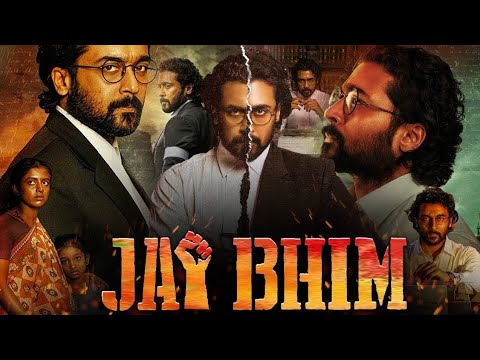Introduction: The Battle Between Silence and Voice
Jai Bhim is not merely a film—it is a cinematic uprising. Directed by T.J. Gnanavel and led by a searing performance from Suriya as Chandru, the film transforms the screen into a courtroom, not just of law, but of conscience. Based on real events, Jai Bhim thrusts its audience into the heart of India’s caste-driven inequities and judicial corruption, not with sentimentality but with righteous rage.
What separates Jai Bhim from standard courtroom dramas is not just its legal intricacy or gritty realism—it’s the weight of history, the sharpness of social commentary, and the deep humanity it brings to marginalized voices. The film doesn’t beg for empathy. It demands recognition, demands accountability, and demands change.
Narrative Overview: The Anatomy of Injustice
Set in the 1990s in Tamil Nadu, the story follows Sengeni and Rajakannu—an Irular tribal couple whose quiet life is shattered when Rajakannu is arrested on false theft charges. What begins as a simple criminal accusation rapidly morphs into a harrowing tale of custodial violence, bureaucratic apathy, and caste-based oppression.
Rajakannu disappears from police custody, and with the state machinery stacked against her, Sengeni turns to advocate Chandru, a fiery, principled lawyer known for taking up cases of the downtrodden. What unfolds is not just a legal case but a moral reckoning—an excavation of systemic rot, layer by layer, lie by lie.
The brilliance of the narrative lies in how it carefully interweaves the personal pain of Sengeni with the procedural fight of Chandru, never allowing one to eclipse the other. The result is a tightly woven drama where truth is the ultimate rebellion.
Characters: Living Symbols of Structural Struggle
1. Chandru (Suriya): The Relentless Advocate
Chandru is not a cinematic lawyer who wins with dramatic monologues—he is a strategist, a listener, and a firebrand with deep integrity. He doesn’t represent the Irular tribe because he is a savior. He does it because the system owes them justice.
His character becomes a symbol of allyship—someone who uses his privilege, education, and access not to dominate the narrative, but to dismantle the walls of oppression from within the system. His journey is not one of transformation, but of moral steadiness, holding fast against the storm of institutional denial.
What makes Chandru remarkable is his refusal to compromise. When witnesses are threatened, when police fabricate stories, when the court is lulled into convenience, Chandru pushes forward—not just with facts, but with conviction that the truth deserves more than lip service.
2. Sengeni (Lijomol Jose): The Pillar of Silent Strength
Sengeni is the emotional nucleus of Jai Bhim. Her arc is a masterclass in restrained yet powerful storytelling. From a grieving wife to a fighter for justice, her pain never translates into helplessness. It becomes fuel for her resolve.
She does not speak in impassioned speeches. She does not collapse under the weight of tragedy. Instead, she represents millions of women from oppressed communities—women whose lives are systematically erased, but whose strength is monumental.
Her scenes—often silent, often framed in harsh lighting—show the chasm between the world she inhabits and the system built without her in mind. But she never seeks to escape that world. She stands tall, rooted in her truth, and through her endurance, forces the legal system to listen.
3. Rajakannu (Manikandan): The Vanished Everyman
Rajakannu’s presence haunts the film like a spirit trapped between existence and erasure. A skilled snake-catcher, a gentle father, a man of dignity—he is arrested not because he is guilty, but because his caste renders him disposable in the eyes of the police.
Though physically absent in much of the film, Rajakannu is omnipresent. Every scene in the courtroom, every tear of Sengeni, every rebuttal by Chandru—all orbit the central injustice done to him. He is a tragic representation of how the system doesn’t kill bodies—it erases identities.
Caste as the Invisible Villain: The True Antagonist
Unlike conventional thrillers with clear villains, Jai Bhim doesn’t give evil a single face. The antagonist is structural—it is caste, institutionalized apathy, and bureaucratic decay. The police officers, particularly the corrupt Sub-Inspector, are not cartoonish villains but functionaries of a toxic hierarchy.
The brilliance of the film is how it never explicitly shouts casteism—it lets it bleed through the cracks. From the way officials ignore Sengeni’s pleas, to how the tribal community is regarded as invisible by the state, caste is the framework in which all crimes occur.
The courtroom becomes a metaphorical battlefield—not just of legal arguments, but of two Indias: one that exists in law books, and one that is denied rights, identity, and humanity.
Visual Language: Cinema as Resistance
The cinematography of Jai Bhim is not ornamental—it is confrontational. The camera lingers on bruises, on worn-out saris, on rusted jail bars. It doesn’t romanticize poverty or tribal life—it presents them in stark realism, making it impossible for the audience to turn away.
Close-ups on Sengeni’s face often dominate the screen, letting her silent rage fill the frame. The use of natural lighting during courtroom scenes creates an atmosphere of procedural dryness, disrupted only by the flicker of hope that Chandru brings with each legal argument.
Dark interiors of police stations are contrasted with open tribal fields—symbolizing how freedom exists outside the state, but survival depends on navigating its cruelty.
The sound design—especially the absence of music during scenes of violence—adds to the rawness. The silence isn’t peaceful—it’s accusatory. It speaks louder than any scream could.
Themes:
1. Justice vs. Legality
One of the film’s core interrogations is whether legality truly equates to justice. Time and again, the law is shown as procedurally correct but morally bankrupt. Witnesses are silenced through bureaucracy. Evidence is fabricated with the veneer of legality.
Chandru’s brilliance lies not just in fighting for justice, but in weaponizing the law against those who misuse it. He shows that the same codes used to suppress can be used to liberate—if one has the will and courage to do so.
2. Voice vs. Silence
The tribal community is largely voiceless in society—not by choice, but by design. Sengeni’s journey becomes one of finding a voice in a space that never made room for it.
Each statement she gives, each time she walks into the courtroom, she chips away at the silence cast upon her. Chandru is not her voice—he is her amplifier. The voice was always hers. The system simply refused to hear it.
3. The Banality of Brutality
What is perhaps most horrifying about the custodial torture scenes is not just their cruelty—but how casual the officers are. There is no remorse. No urgency. It is normalized. The film doesn’t sensationalize violence—it documents it with cold clarity.
This choice forces viewers to confront not just individual sadism but a culture that protects and perpetuates it. It is not rogue cops—it is a rogue system.
Courtroom as Crucible: A Space of Transformation
The courtroom in Jai Bhim is not just a location. It’s a crucible where ideology, identity, and power collide. Every cross-examination is a battle not just of facts, but of ethics. Every objection, every sustained argument reflects deeper societal hierarchies.
Unlike films that dramatize courtrooms with theatrics, Jai Bhim maintains procedural accuracy while never losing emotional impact. The evidence collection, witness interrogation, and affidavit filings are all acts of rebellion, rendered cinematic through their consequence.
The court is where Chandru wages war—not with weapons, but with precedents, loopholes, and clarity.
Climax and Catharsis: Justice, Not Victory
The resolution of the case brings accountability, but not complete healing. Rajakannu remains lost. His death is not avenged by punishment alone—it is remembered by the change his case inspires.
The triumph is not in a prison sentence for the guilty—it is in forcing the system to admit guilt, to accept that it failed, and to restore dignity to those it tried to erase.
Sengeni walks away not with closure, but with the weight of truth made public. Her tears at the end are not of relief—they are of survival, after walking through fire.
Symbolism and Cultural Resonance
The title Jai Bhim itself is a rallying cry linked to Dr. B.R. Ambedkar, the architect of India’s Constitution and the most revered voice against caste-based oppression. The film channels Ambedkar’s legacy not through quotes, but through action—legal empowerment, resistance, and assertion of equality.
Even Chandru’s methods reflect Ambedkarite thought: use of law as a tool of revolution, not appeasement.
The film resonates across languages and regions because its themes are tragically universal—oppression is not localized, and justice is a global hunger.
Conclusion: A Film That Holds the Mirror—And Breaks It
Jai Bhim is not just a story—it is a scream, a document, a wound, and a weapon. It does not ask for your sympathy. It demands your discomfort. It pierces through cinematic illusion and forces us to face the rot beneath our institutional surfaces.
Through its raw storytelling, committed performances, and unflinching gaze, the film becomes more than entertainment—it becomes a record of resistance.
It proves that the law can be both the oppressor’s shield and the victim’s sword—depending on who wields it.
In its final act, Jai Bhim does not ask if the system works. It asks if we will let it fail again.

